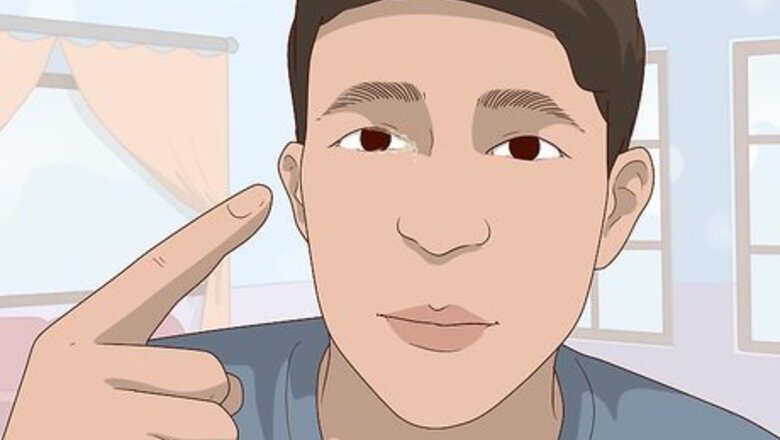
views
Removing the Eye

Clean your prosthetic when your eye socket starts to feel irritated. If you notice that the inside of your eyelid or your eye socket starts to feel itchy, or if you notice that your eye is watering more than normal, it's probably time to clean your eye. However, the amount of time between cleanings varies widely from person to person, so talk to your ocularist about how often to clean your eye. Tip: Make a note in your calendar when you wash your eye. Then, make another note when the eye needs to be cleaned again. Use the time between cleanings to estimate how often you prefer to clean your eye. You might clean your prosthesis every day, or you might prefer to clean it monthly or every several months. You might even choose to clean only your eyelid area at home, allowing your ocularist to clean during your normal polishing appointments every few months. If you're wearing a conformer, which is a lens that holds the shape of your natural eye, your ocularist will likely instruct you to clean it twice a day.

Spread a towel over your work area before you take out your eye. Choose a thick, soft towel and place it over the area where you'll be working, like on your countertop, inside your sink, or across your lap. That way, if the eye falls, it will have a soft surface to land on. While prosthetic eyes are typically made to be very durable, there is still a risk that they may be chipped, cracked, or scratched if you drop them onto a hard surface.
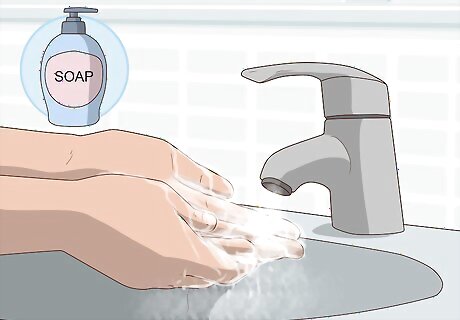
Wash your hands with soap and water before you handle your prosthesis. Always wash your hands thoroughly with soap and water before you remove your prosthesis or touch your eye area. This will help reduce the risk that you'll spread bacteria, dirt, or other contaminants to your eye socket. If you need to adjust your prosthesis and you don't have access to soap or running water, use hand sanitizer, instead. However, it's best to avoid touching your artificial eye as much as possible.
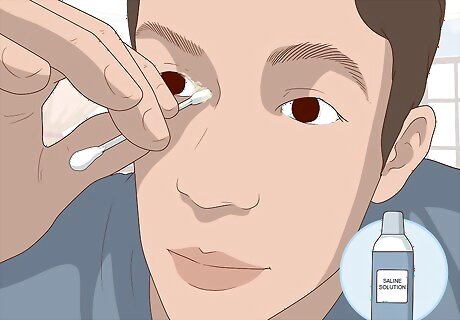
Clean your eyelids with saline solution. Dip a cotton ball or a cotton swab in a sterile saline solution, like the kind used for contact lenses. Then, wipe across your upper eyelid from your nose toward your ear. Use a second cotton ball to wipe your lower eyelid, as well. If you need to wipe the eyelid more than once to remove discharge, use a fresh cotton ball or swab each time. If you don't have a saline solution on hand, boil water to sterilize it, then let it cool and use that instead.

Pull down your lower eyelid with one finger. Use the index finger on one hand to gently pull your lower eyelid down. Keep pulling until you see the bottom edge of the prosthesis inside your eyelid. Remember to do this over the towel you placed on your work area. Your ocularist will go over the process of removing your eye with you, but it's a simple procedure that will get easier with practice. If you have trouble removing your prosthetic eye with your fingers, ask your ocularist for a removal tool that has a suction cup. That way, your prosthesis will stick to it easier.

Cup your other hand and press gently on your upper eyelid. Curve your hand into a C-shape and hold it over your eye socket. Then, use your fingertips to gently press into the crease on your upper eyelid. The prosthesis will slip out and fall into your cupped hand. It's normal to see some discharge on the prosthetic when you remove it. If you have trouble removing your eye, talk to your ocularist about a suction cup tool that may help.
Washing Your Prosthesis
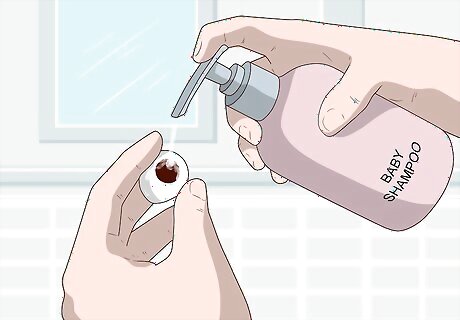
Apply a drop of soap to the surface of the prosthesis. Choose a mild soap for cleaning your prosthesis. For instance, you might use unscented hand soap or baby shampoo. Just use a very small amount, since it might be harder to rinse away all of the soap if you use a lot of it. Avoid using scented soap, since the additives in the fragrance might stay behind and irritate your eyes. Only use mild soap, such as baby shampoo. You should never use chemicals, alcohol, detergents, or disinfectants to clean your prosthesis. If you have any questions about the type of soap that's best for your artificial eye, talk to your ocularist.
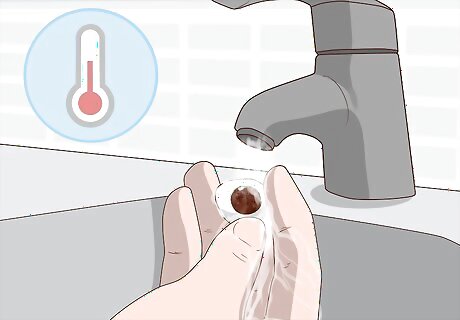
Wash the eye in warm water, then rinse it well. Add a little warm water to the prosthesis, but be careful not to rinse all of the soap away. Then, use your fingers to gently lather the soap over the entire surface of the prosthetic eye. When you're finished, hold the prosthesis under the warm running water until all of the soap is rinsed away. Be sure to hold the prosthesis over the towel the whole time you're cleaning it.

Rinse the eye again, this time using saline. Once you've removed all of the soap, pour some saline solution over your eye. This will sterilize the prosthesis, and it will also help prepare it to be reinserted. You can use boiled, cooled water in place of the saline if you need to.

Lift your upper eyelid and slide the prosthesis back into place. Look down and lift your upper eyelid with one fingertip. Then, slide the prosthesis behind your eyelid with an upward motion. Let go of your eyelid while still holding the prosthesis with your other hand. Then, use your free hand to gently pull down your lower eyelid. The prosthesis should easily slip into place.
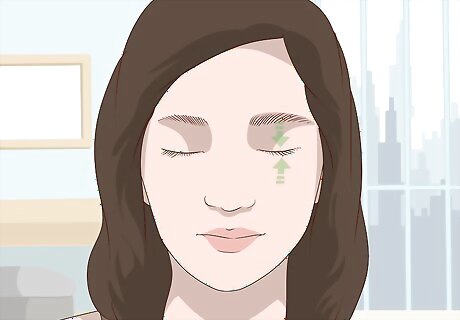
Blink several times once the prosthesis is in place. After you insert your prosthesis, blink a few times to make sure your eye closes comfortably. If not, press gently on the prosthetic eye and move your finger to reposition it. If that doesn't work, remove your prosthetic eye and reinsert it.
Maintaining Your Prosthetic Eye
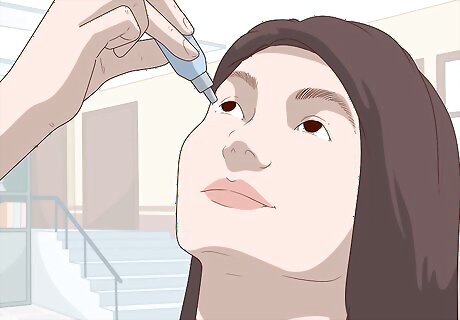
Use artificial tears to help prevent or relieve eye irritation. Eye drops will help your body keep your eye socket and prosthetic eye lubricated, and they'll also help slow the natural protein buildup that occurs on artificial eyes. Your ocularist will likely prescribe you special eye drops to use, so be sure to talk to them about how often to use the drops and whether any over-the-counter options are acceptable. However, they'll likely advise you to use the drops 3-4 times a day. You'll likely be prescribed antibiotic eye drops immediately after you get your prosthesis, as well as any time you have an infection in your eye socket.

Apply lubricating gel or petroleum jelly along your eyelashes before bed. Use a cotton swab to spread a very small amount of lubricating gel, petroleum jelly, or liquid paraffin along the edge of your lashes each night. Your eye will produce some discharge as you sleep, and these lubricants can help prevent that discharge from crystallizing overnight. Always talk to your ocularist before you add anything to your daily regimen. You can use oil lubricant and artificial tears at the same time to make it more comfortable to wear. Did You Know? Generally, it's okay to wear your prosthesis while you sleep. However, if you still have your eye and you wear a shell on top of it, you should remove the shell while you sleep. In that case, keep the prosthesis in a container of water overnight.

Soak the prosthesis in contact solution every 1-3 months to remove protein. Fill a container with contact solution and place the prosthesis in the solution for about half an hour. Then, take the prosthesis out of the solution and wipe the surface with a wet tissue. Rinse the eye, then reinsert it. The lubricants produced by your eye contain protein. Over time, this creates a film that can harden and build up on the surface of the prosthesis.

Have your eye professionally polished as often as your ocularist recommends. During a polishing appointment, your ocularist will buff out any scratches to your prosthesis, and they'll also restore the shine to your prosthetic eye that helps it look more natural. The doctor will also check the health of your eye socket and eyelids, and will make sure that your prosthesis still fits properly. Typically, you'll have these appointments about 1-2 times a year.

Replace the prosthesis every 3-5 years. Unless your prosthetic eye is lost or damaged, it should last you for several years. However, if the prosthesis is for a child, you may need to replace it more often to ensure a good fit as the child grows. Your ocularist will likely advise you when it's time to consider a replacement.

Call your ocularist if you notice swelling, eye pain, or increased discharge. While some eye irritation is common when you're wearing a prosthetic eye, it shouldn't be painful to wear your prosthesis. Also, green or yellow discharge can indicate that you have an eye infection. In either case, it's important to talk to your ocularist right away to resolve the problem. In the case of an infection, you'll likely be prescribed antibiotic eye drops.










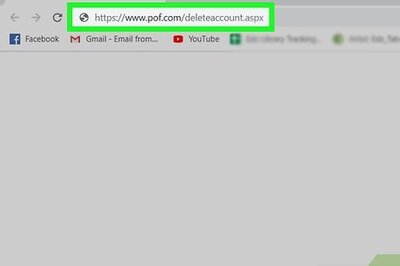
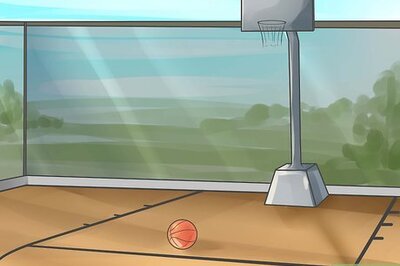





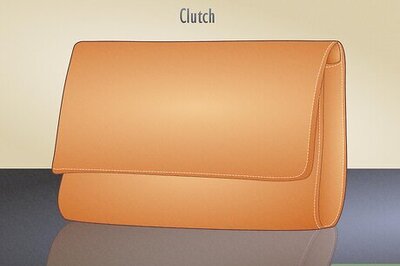
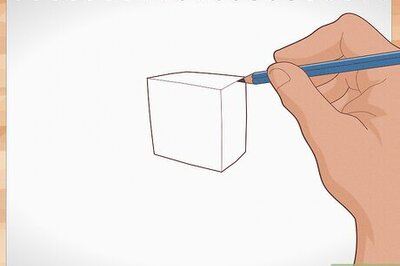
Comments
0 comment